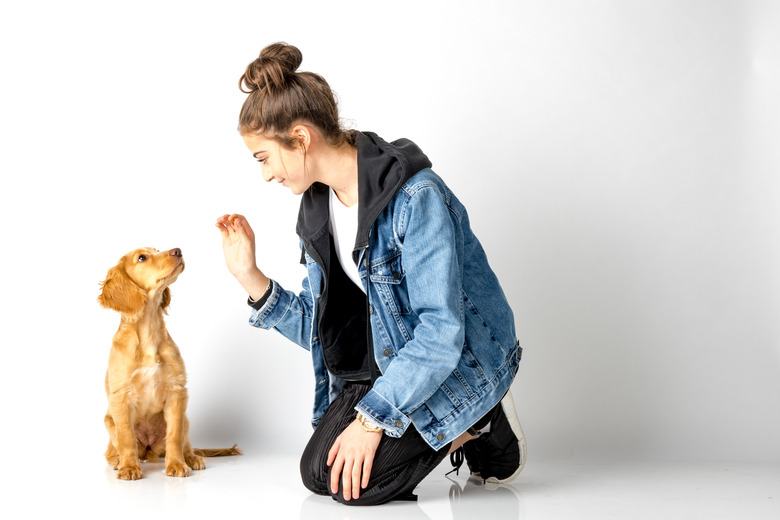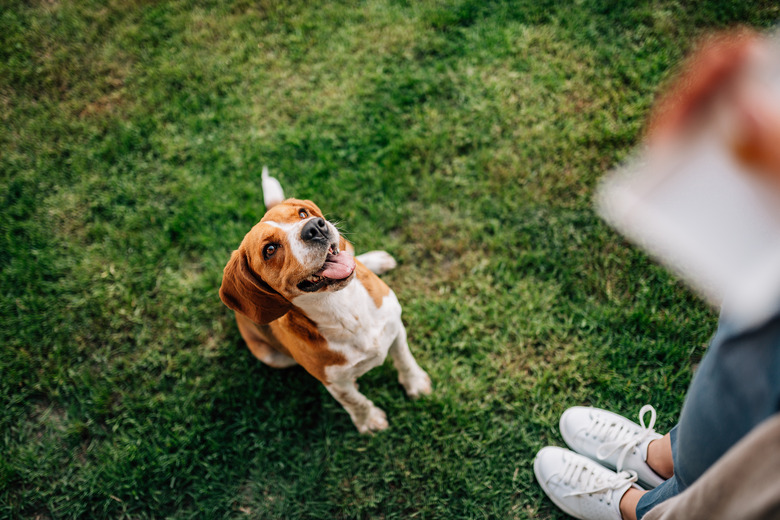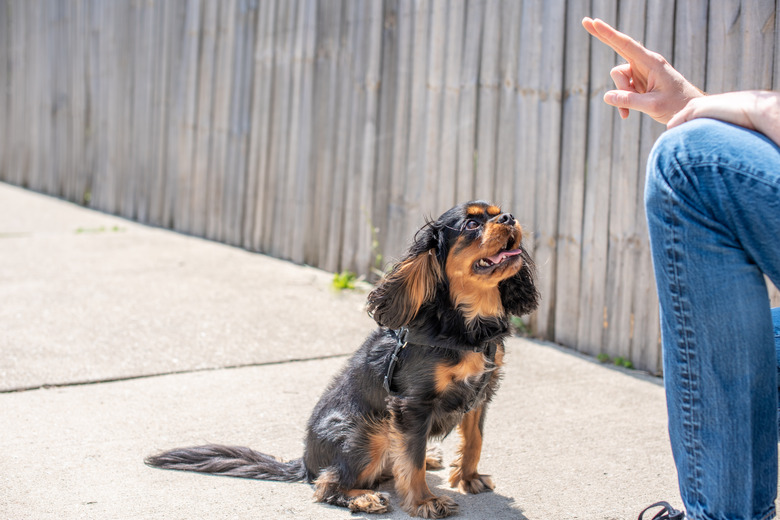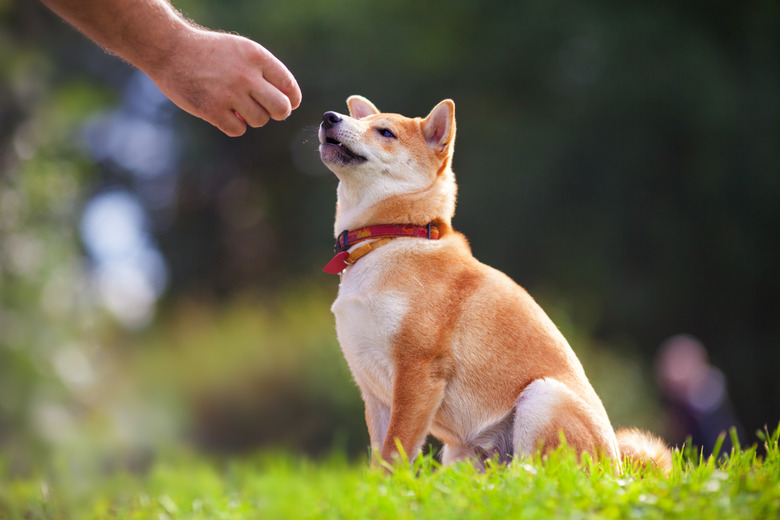How To Train A Dog To Greet Politely
Our dogs live in the lap of luxury. We brag about them to our friends, lavish affection upon them, and pick up their poop. All we ask in return is that our dog follows a few simple rules. Because, like humans, dogs are capable of being good citizens. Teaching your dog how to be a good citizen requires some consistency in their training and cooperation from the people around you.
If your dog is jumping on you, your family, or your guests out of excitement, you must teach them a new way of saying hi! For those dogs who have not quite nailed politeness in their greeting skills, don't give up hope! There are some simple exercises you can do to rewrite this behavior.
How "impolite" greetings are reinforced
How "impolite" greetings are reinforced
You may not know it, and surely your houseguests don't mean to do it, but they may actually be teaching your dog undesirable habits each time they greet each other. Typically, guests often fuss over and encourage over-excitement in dogs! After all, your dog is friendly, excited, and totally irresistible. Consequently, not only is her boisterous welcome permitted, it's encouraged. This is known as intermittent reinforcement and it is extremely effective at building strong, persistent behavior!
From bruises and scratches to knocking over the elderly and children, the consequences of encouraging jumping and overexcitement can be dangerous. But how do you turn your overexcitable dog into a calm, cool, collected canine who greets people and other dogs — at home and out in public — politely?
Replacing an undesirable behavior with a desirable behavior
Replacing an undesirable behavior with a desirable behavior
Maybe it's time to teach your dog a desirable behavior to replace the undesirable one, recommends Karen Pryor, author of Don't Shoot the Dog and a leader in the field of animal training and in the science and application of positive reinforcement.
The objective of clicker training or any positive reinforcement training is reinforcing the behavior you want rather than scolding or giving any undue attention to the behavior you don't want. After consistent reinforcement, your dog learns it's not worth his time to jump or bark or cause a commotion because he can get more attention, and maybe even treats, for offering polite behavior instead.
Teaching your dog to sit reliably can be an essential tool in teaching your dog how to greet both people and other dogs politely, and it comes in handy in so many different situations you and your dog will encounter during her lifetime.
The first step to polite greetings: a reliable "sit"
The first step to polite greetings: a reliable "sit"
Teaching your dog to sit consistently in every circumstance you ask of him will be the foundation of his new polite greeting. "Sit" when greeting people becomes the new "jump," or when greeting other dogs, the new "lunge" so to speak. Train for precisely what you want with the goal of achieving a reliable sit upon your cue no matter the distractions; whether it be food, people, dogs, squirrels, traffic, etc.
Practice, practice, practice the sit. In a nutshell, a beautiful sit is accomplished by the repetitive practice of either capturing or luring, two effective basic dog-training techniques.
- Capturing: Stand in front of your dog holding a treat, then wait for her to sit. When she sits, say "yes"/praise, or click, if clicker training, and give the treat. Now step backward or sideways to encourage her to stand, and wait for another sit. Give the treat.
- Luring:
To lure the sit from a stand, use a treat to draw your dog's nose up and back. Her rear-end will naturally go into a sit as her head goes back. Say "yes"/praise/or click and give her the treat.
Train the sit in different locations and add elements such as duration, distance, and distractions, says Karen Pryor. Reliability, thus perfection, will only come from proofing everything you've taught in every situation you plan to give the sit cue, such as greeting both people and other dogs.
Greeting you and family members politely
Greeting you and family members politely
Arriving home to a warm, yet polite welcome from your canine best friend is a wonderfully relaxing feeling. Right now, if he's jumping all over you, it may seem like an impossible dream. But practice the alternative behavior, such as a sit, or even at least keeping all four paws on the floor, until it's second nature for him. During practice, keep treats handy to reward the desired behavior. If your dog jumps on you, don't talk to, look at, or touch your dog. Simply turn your back or walk away.
It's important that your dog learns that jumping gets them no attention, even though you may have encouraged your dog's exuberant greetings in the past. Keep your demeanor as calm as possible. Remain low-key. Practice consistently and often, perhaps dozens of times, to get the results you want. Most dogs will catch on quickly, but take as much time as he needs.
Training your dog to greet visitors politely
Training your dog to greet visitors politely
Your visitors should be prepped in advance so they understand what you are trying to accomplish. That way, they will not encourage jumping or dole out praise for bad behavior. Their job is to ignore jumping and reward (with pets or treats) sitting and four paws on the floor. Regular visitors can get in on the training by knocking on the door, entering, and going through the process of ignoring bad behavior and rewarding the sit, or good behavior you have been teaching her. If guests visit often enough, your dog will have this down pat in no time.
In the meantime, until your dog has mastered the polite greeting, use management to protect your guests from jumping and scratching. You can have your dog on leash, in a crate, or in an adjoining room restrained by a baby gate.
Training your dog to greet people on a walk politely
Training your dog to greet people on a walk politely
Remember, you're in charge. You can tell a person to please not approach your dog, or to please not pat your dog. Your dog is not community property. Imagine if people you didn't know ran up and wanted to hug you. Put yourself in your dog's paws. People need to respect you and your dog's space. Being polite goes both ways. If you're one to stand your ground, you can try to communicate via vests, leash wraps, or bandanas on your dog. These items could say "dog in training" to communicate to strangers that you'll have rules for greetings.
Sometimes easier than expecting your dog to sit for an exciting stranger is teaching a cue called Go Say Hi. "We have learned that is often difficult to keep an excited dog in a sit while greeting someone new," says trainer Cassie Pestana, KPA-CTP, CPDT-KA. "The dog often jumps during petting or after the petting has stopped. Therefore, we now teach 'go say hi' which consists of a brief interaction with the stranger and then a return to you for a treat." Pestana explains that this is done for a few important reasons: we get the dog's consent in performing the behavior, it keeps treats in YOUR hands so that YOU get more and more excited in the presence of other people, and it allows for a quick greeting before jumping can ensue.
Assuming that everyone is friendly and interested in meeting, this technique can also work when introducing dogs to one another.
Polite dog-to-dog greetings
Polite dog-to-dog greetings
Polite dog-to-dog greetings depend on several factors, including your dog's level of socialization. It's important to socialize your dog early and often in a variety of situations, and particularly with other well-behaved dogs. Your dog's desire for social interactions and past experiences in meeting dogs — positive or negative — also plays a major role in whether a meet-up goes smoothly or is a complete disaster.
Pat Miller, CBCC-KA, CPDT-KA, suggests limiting greetings with other dogs. After all, most of the time, the "walk" is a way for you and your dog to bond. That being said, if another dog seems like a good candidate for meeting, make sure you are carrying some high-value treats to aid in the interaction. She offers some sage advice: "When you see a dog you would like yours to greet, ask permission from the other owner first, and respect their wishes. If they say no, it's a no – don't try to talk them into it. Conversely, be politely firm with your "no" if someone wants to approach yours with a dog you're not comfortable with. Be your dog's advocate."
For the greeting, loosen up the leash since a taut one creates tension in your dog. Do some parallel walking so the dogs glean a little more information about the other prior to engaging. Pay careful attention to both dogs' body language throughout their encounter. Abort if necessary.
If both dogs are comfortable walking in proximity to the other, coordinate with the other owner and allow the dogs to further interact while keeping the leashes loose. Keep greetings short and sweet!
References
- Whole Dog Journal: How to Teach Your Dog to Greet Nicely
- Clicker Training: Help, We're Being Invaded! How to Train Polite Greetings
- AKC: Teach Your Puppy These Five Basic Commands
- The Humane Society of the United States: Stop Your Dog From Jumping Up
- Clicker Training: Training Your Dog to Sit
- AKC: Canine Good Citizen



